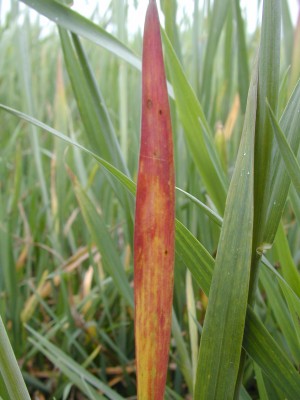Barley Yellow Dwarf
 Causal Agent
Causal Agent
Barley yellow dwarf virus
Hosts
Wheat, barley, oats, etc. Barley yellow dwarf virus attacks oats and wheat is transmitted by many species of aphids. In Oklahoma, the two most common aphids associated with transmission are the bird-cherry oat aphid (Rhopalosiphum padi) and the greenbug (Schizaphis graminum).
Symptoms

Control
Some wheat varieties such as 2137 and Custer have some tolerance to barley yellow dwarf, but no variety is highly resistant. Controlling the aphid vectors with chemicals will help to limit incidence and spread of barley yellow dwarf, but frequently aphids transmit the virus before reaching levels believed sufficiently high to merit application of an insecticide. Planting late also helps reduce incidence and severity of barley yellow dwarf because of the reduce time in the fall for aphid infestations and transmission of the virus. Please contact your local county extension office for current information.
Additional information can be found in the most current OSU report of barley yellow dwarf control on wheat.
For more information you may contact Dr. Robert Hunger, e-mail address: rmh@okstate.edu

